Organization Behavior Report: GSK, Leadership, Structure, and Culture
VerifiedAdded on 2019/12/28
|15
|4574
|125
Report
AI Summary
This report provides a comprehensive analysis of organizational behavior, focusing on the case of GlaxoSmithKline (GSK). It explores the crucial roles of organizational culture and structure in influencing employee performance and overall business success. The report delves into GSK's specific organizational culture, highlighting its emphasis on employee value and open communication, and its adoption of a horizontal organizational structure. It contrasts GSK's approach with that of Atos healthcare, examining different leadership styles and organizational structures. Furthermore, the report examines the factors influencing individual behavior in the workplace, including race, culture, gender, perception, and job responsibility, and the impact of effective communication. The report also explores leadership styles, with a focus on democratic and autocratic approaches, and organizational theory, specifically the contingent theory. Finally, it touches upon scientific management principles and their relevance to improving economic efficiency and employee productivity.
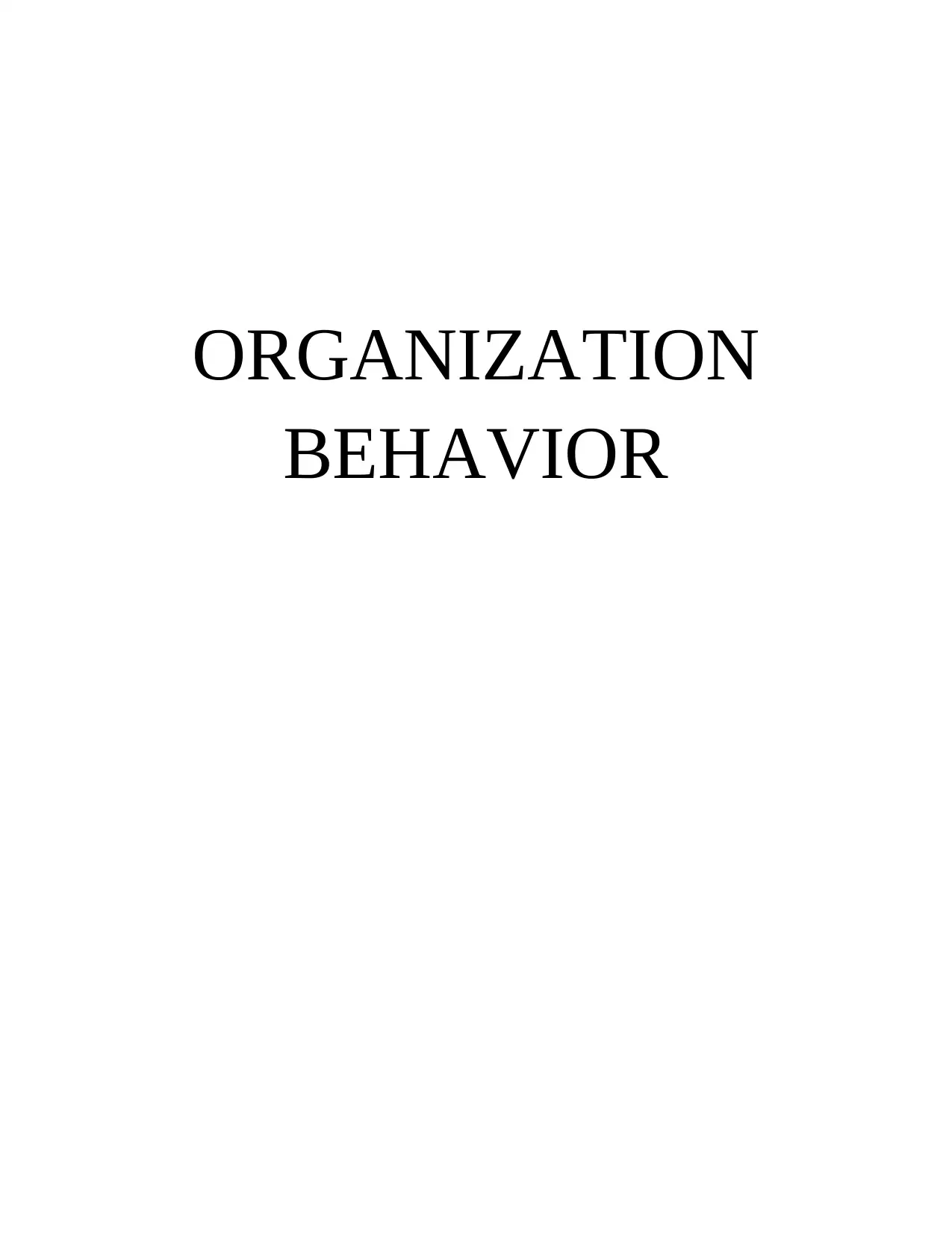
ORGANIZATION
BEHAVIOR
BEHAVIOR
Paraphrase This Document
Need a fresh take? Get an instant paraphrase of this document with our AI Paraphraser
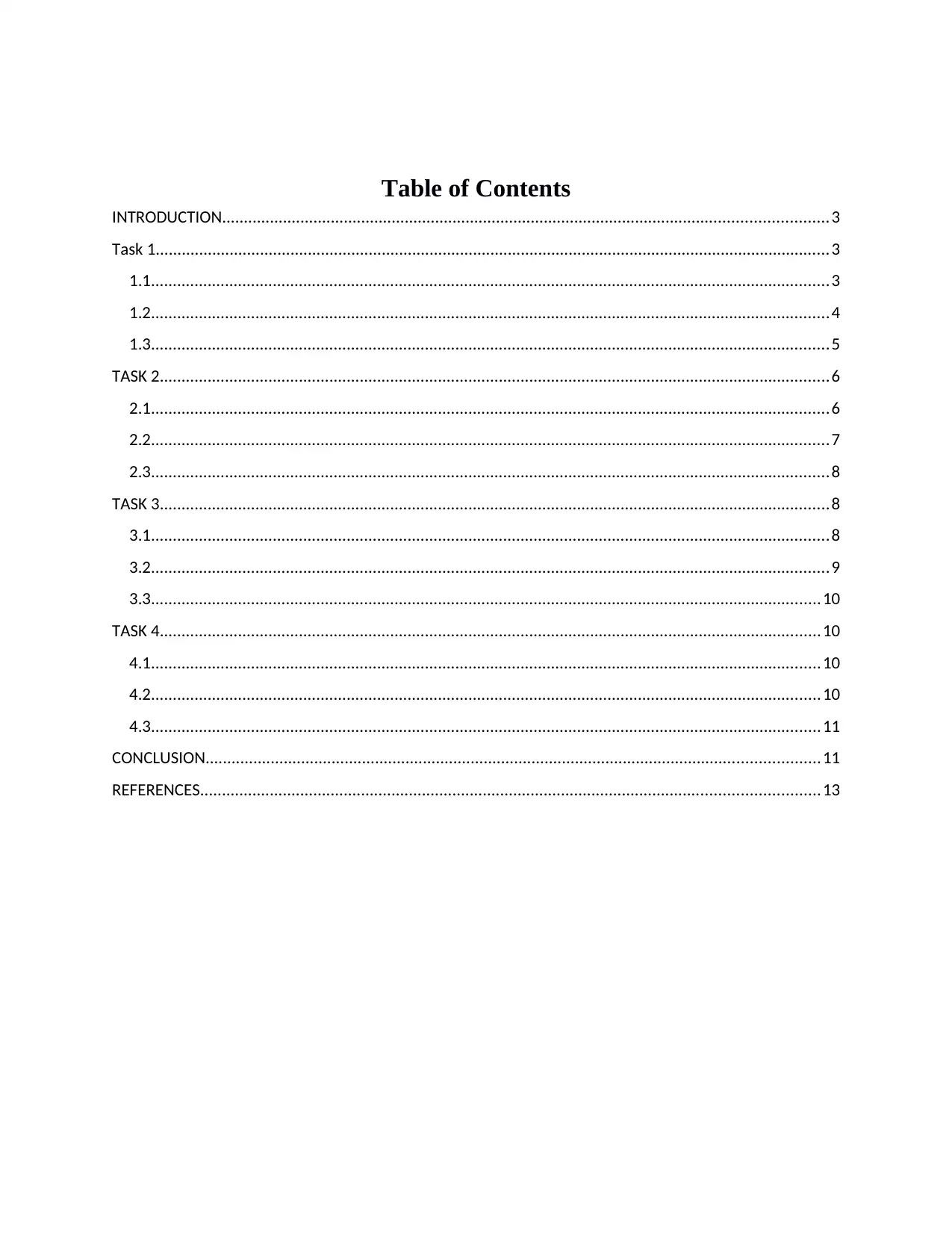
Table of Contents
INTRODUCTION...........................................................................................................................................3
Task 1...........................................................................................................................................................3
1.1............................................................................................................................................................3
1.2............................................................................................................................................................4
1.3............................................................................................................................................................5
TASK 2..........................................................................................................................................................6
2.1............................................................................................................................................................6
2.2............................................................................................................................................................7
2.3............................................................................................................................................................8
TASK 3..........................................................................................................................................................8
3.1............................................................................................................................................................8
3.2............................................................................................................................................................9
3.3..........................................................................................................................................................10
TASK 4........................................................................................................................................................10
4.1..........................................................................................................................................................10
4.2..........................................................................................................................................................10
4.3..........................................................................................................................................................11
CONCLUSION.............................................................................................................................................11
REFERENCES..............................................................................................................................................13
INTRODUCTION...........................................................................................................................................3
Task 1...........................................................................................................................................................3
1.1............................................................................................................................................................3
1.2............................................................................................................................................................4
1.3............................................................................................................................................................5
TASK 2..........................................................................................................................................................6
2.1............................................................................................................................................................6
2.2............................................................................................................................................................7
2.3............................................................................................................................................................8
TASK 3..........................................................................................................................................................8
3.1............................................................................................................................................................8
3.2............................................................................................................................................................9
3.3..........................................................................................................................................................10
TASK 4........................................................................................................................................................10
4.1..........................................................................................................................................................10
4.2..........................................................................................................................................................10
4.3..........................................................................................................................................................11
CONCLUSION.............................................................................................................................................11
REFERENCES..............................................................................................................................................13
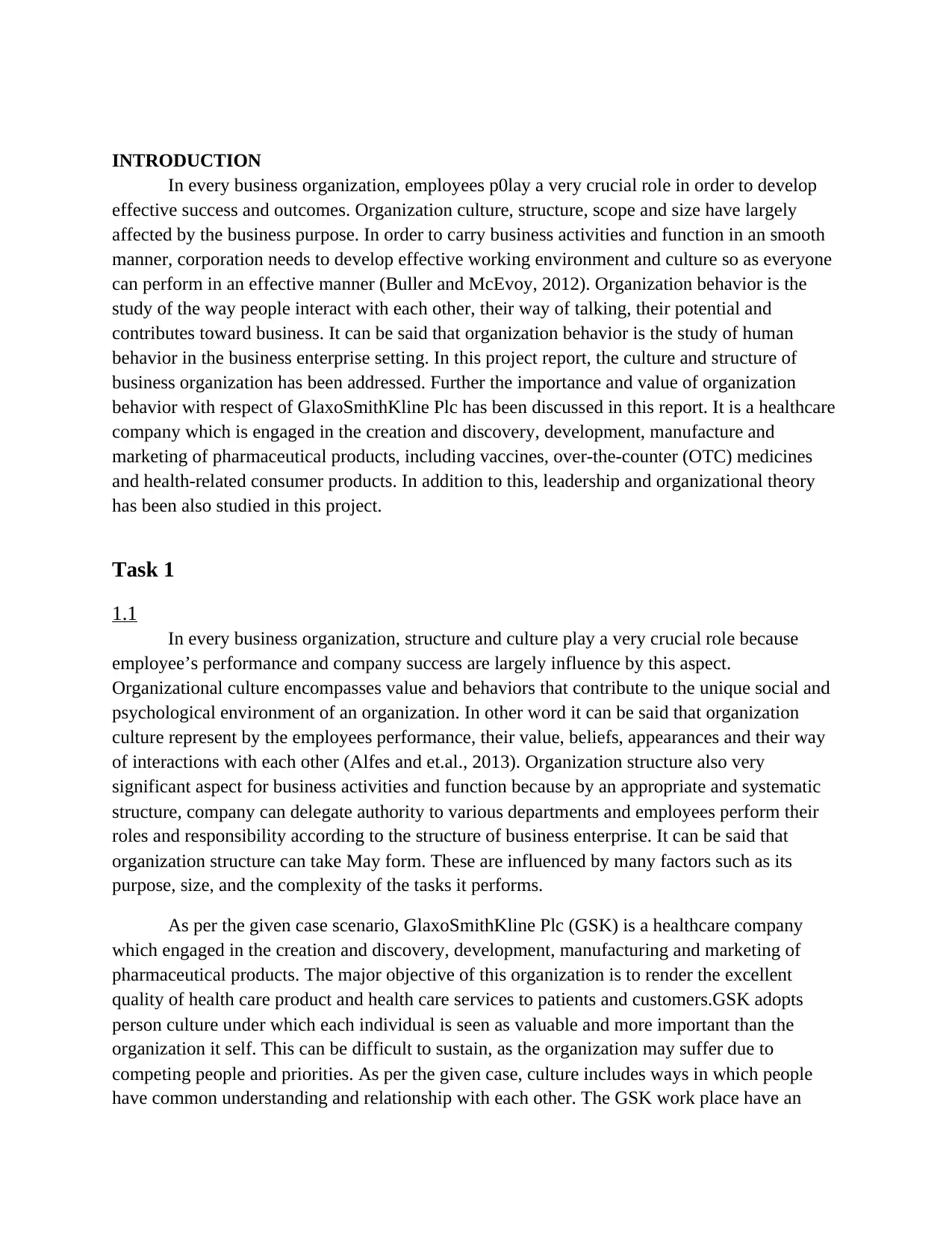
INTRODUCTION
In every business organization, employees p0lay a very crucial role in order to develop
effective success and outcomes. Organization culture, structure, scope and size have largely
affected by the business purpose. In order to carry business activities and function in an smooth
manner, corporation needs to develop effective working environment and culture so as everyone
can perform in an effective manner (Buller and McEvoy, 2012). Organization behavior is the
study of the way people interact with each other, their way of talking, their potential and
contributes toward business. It can be said that organization behavior is the study of human
behavior in the business enterprise setting. In this project report, the culture and structure of
business organization has been addressed. Further the importance and value of organization
behavior with respect of GlaxoSmithKline Plc has been discussed in this report. It is a healthcare
company which is engaged in the creation and discovery, development, manufacture and
marketing of pharmaceutical products, including vaccines, over-the-counter (OTC) medicines
and health-related consumer products. In addition to this, leadership and organizational theory
has been also studied in this project.
Task 1
1.1
In every business organization, structure and culture play a very crucial role because
employee’s performance and company success are largely influence by this aspect.
Organizational culture encompasses value and behaviors that contribute to the unique social and
psychological environment of an organization. In other word it can be said that organization
culture represent by the employees performance, their value, beliefs, appearances and their way
of interactions with each other (Alfes and et.al., 2013). Organization structure also very
significant aspect for business activities and function because by an appropriate and systematic
structure, company can delegate authority to various departments and employees perform their
roles and responsibility according to the structure of business enterprise. It can be said that
organization structure can take May form. These are influenced by many factors such as its
purpose, size, and the complexity of the tasks it performs.
As per the given case scenario, GlaxoSmithKline Plc (GSK) is a healthcare company
which engaged in the creation and discovery, development, manufacturing and marketing of
pharmaceutical products. The major objective of this organization is to render the excellent
quality of health care product and health care services to patients and customers.GSK adopts
person culture under which each individual is seen as valuable and more important than the
organization it self. This can be difficult to sustain, as the organization may suffer due to
competing people and priorities. As per the given case, culture includes ways in which people
have common understanding and relationship with each other. The GSK work place have an
In every business organization, employees p0lay a very crucial role in order to develop
effective success and outcomes. Organization culture, structure, scope and size have largely
affected by the business purpose. In order to carry business activities and function in an smooth
manner, corporation needs to develop effective working environment and culture so as everyone
can perform in an effective manner (Buller and McEvoy, 2012). Organization behavior is the
study of the way people interact with each other, their way of talking, their potential and
contributes toward business. It can be said that organization behavior is the study of human
behavior in the business enterprise setting. In this project report, the culture and structure of
business organization has been addressed. Further the importance and value of organization
behavior with respect of GlaxoSmithKline Plc has been discussed in this report. It is a healthcare
company which is engaged in the creation and discovery, development, manufacture and
marketing of pharmaceutical products, including vaccines, over-the-counter (OTC) medicines
and health-related consumer products. In addition to this, leadership and organizational theory
has been also studied in this project.
Task 1
1.1
In every business organization, structure and culture play a very crucial role because
employee’s performance and company success are largely influence by this aspect.
Organizational culture encompasses value and behaviors that contribute to the unique social and
psychological environment of an organization. In other word it can be said that organization
culture represent by the employees performance, their value, beliefs, appearances and their way
of interactions with each other (Alfes and et.al., 2013). Organization structure also very
significant aspect for business activities and function because by an appropriate and systematic
structure, company can delegate authority to various departments and employees perform their
roles and responsibility according to the structure of business enterprise. It can be said that
organization structure can take May form. These are influenced by many factors such as its
purpose, size, and the complexity of the tasks it performs.
As per the given case scenario, GlaxoSmithKline Plc (GSK) is a healthcare company
which engaged in the creation and discovery, development, manufacturing and marketing of
pharmaceutical products. The major objective of this organization is to render the excellent
quality of health care product and health care services to patients and customers.GSK adopts
person culture under which each individual is seen as valuable and more important than the
organization it self. This can be difficult to sustain, as the organization may suffer due to
competing people and priorities. As per the given case, culture includes ways in which people
have common understanding and relationship with each other. The GSK work place have an
⊘ This is a preview!⊘
Do you want full access?
Subscribe today to unlock all pages.

Trusted by 1+ million students worldwide
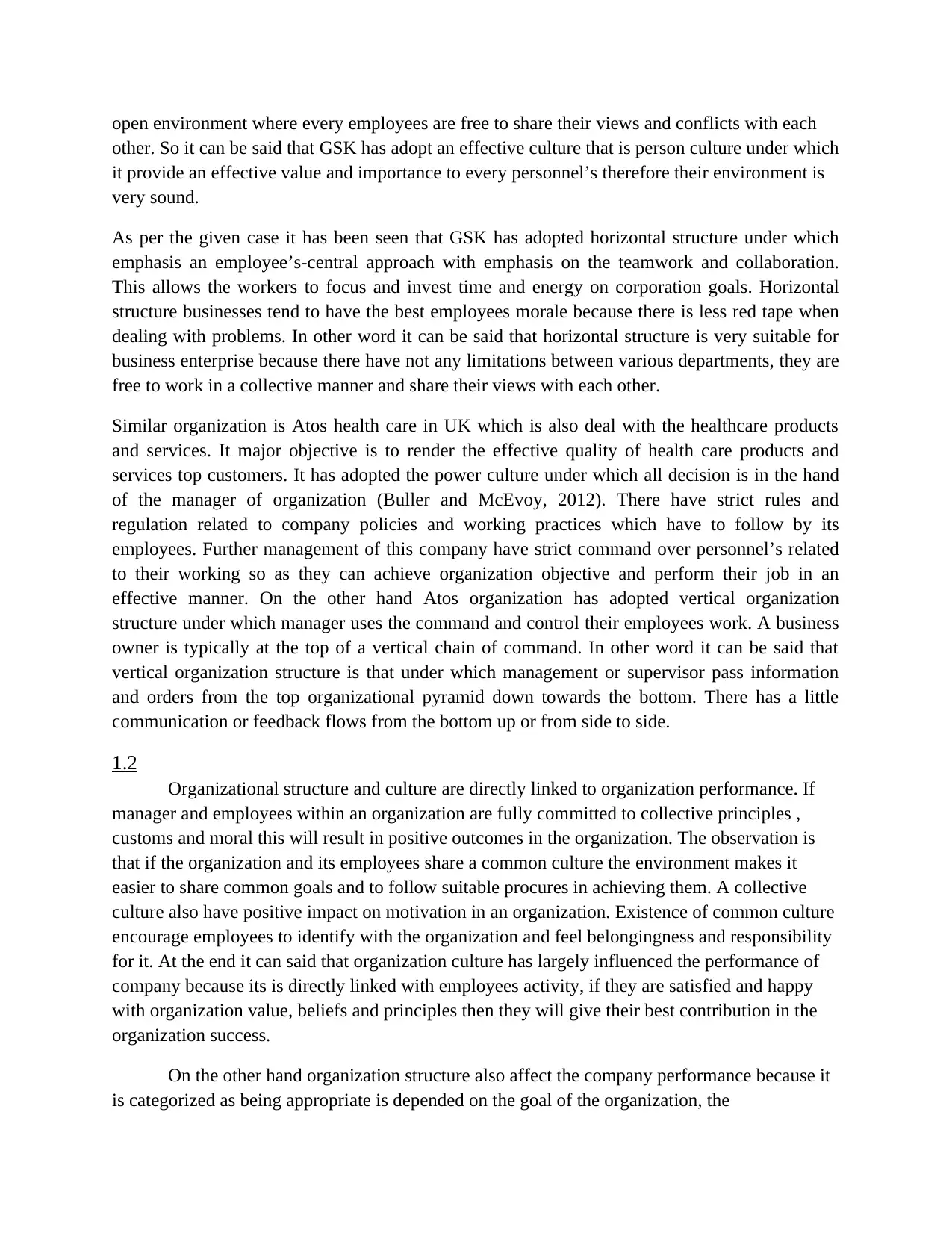
open environment where every employees are free to share their views and conflicts with each
other. So it can be said that GSK has adopt an effective culture that is person culture under which
it provide an effective value and importance to every personnel’s therefore their environment is
very sound.
As per the given case it has been seen that GSK has adopted horizontal structure under which
emphasis an employee’s-central approach with emphasis on the teamwork and collaboration.
This allows the workers to focus and invest time and energy on corporation goals. Horizontal
structure businesses tend to have the best employees morale because there is less red tape when
dealing with problems. In other word it can be said that horizontal structure is very suitable for
business enterprise because there have not any limitations between various departments, they are
free to work in a collective manner and share their views with each other.
Similar organization is Atos health care in UK which is also deal with the healthcare products
and services. It major objective is to render the effective quality of health care products and
services top customers. It has adopted the power culture under which all decision is in the hand
of the manager of organization (Buller and McEvoy, 2012). There have strict rules and
regulation related to company policies and working practices which have to follow by its
employees. Further management of this company have strict command over personnel’s related
to their working so as they can achieve organization objective and perform their job in an
effective manner. On the other hand Atos organization has adopted vertical organization
structure under which manager uses the command and control their employees work. A business
owner is typically at the top of a vertical chain of command. In other word it can be said that
vertical organization structure is that under which management or supervisor pass information
and orders from the top organizational pyramid down towards the bottom. There has a little
communication or feedback flows from the bottom up or from side to side.
1.2
Organizational structure and culture are directly linked to organization performance. If
manager and employees within an organization are fully committed to collective principles ,
customs and moral this will result in positive outcomes in the organization. The observation is
that if the organization and its employees share a common culture the environment makes it
easier to share common goals and to follow suitable procures in achieving them. A collective
culture also have positive impact on motivation in an organization. Existence of common culture
encourage employees to identify with the organization and feel belongingness and responsibility
for it. At the end it can said that organization culture has largely influenced the performance of
company because its is directly linked with employees activity, if they are satisfied and happy
with organization value, beliefs and principles then they will give their best contribution in the
organization success.
On the other hand organization structure also affect the company performance because it
is categorized as being appropriate is depended on the goal of the organization, the
other. So it can be said that GSK has adopt an effective culture that is person culture under which
it provide an effective value and importance to every personnel’s therefore their environment is
very sound.
As per the given case it has been seen that GSK has adopted horizontal structure under which
emphasis an employee’s-central approach with emphasis on the teamwork and collaboration.
This allows the workers to focus and invest time and energy on corporation goals. Horizontal
structure businesses tend to have the best employees morale because there is less red tape when
dealing with problems. In other word it can be said that horizontal structure is very suitable for
business enterprise because there have not any limitations between various departments, they are
free to work in a collective manner and share their views with each other.
Similar organization is Atos health care in UK which is also deal with the healthcare products
and services. It major objective is to render the effective quality of health care products and
services top customers. It has adopted the power culture under which all decision is in the hand
of the manager of organization (Buller and McEvoy, 2012). There have strict rules and
regulation related to company policies and working practices which have to follow by its
employees. Further management of this company have strict command over personnel’s related
to their working so as they can achieve organization objective and perform their job in an
effective manner. On the other hand Atos organization has adopted vertical organization
structure under which manager uses the command and control their employees work. A business
owner is typically at the top of a vertical chain of command. In other word it can be said that
vertical organization structure is that under which management or supervisor pass information
and orders from the top organizational pyramid down towards the bottom. There has a little
communication or feedback flows from the bottom up or from side to side.
1.2
Organizational structure and culture are directly linked to organization performance. If
manager and employees within an organization are fully committed to collective principles ,
customs and moral this will result in positive outcomes in the organization. The observation is
that if the organization and its employees share a common culture the environment makes it
easier to share common goals and to follow suitable procures in achieving them. A collective
culture also have positive impact on motivation in an organization. Existence of common culture
encourage employees to identify with the organization and feel belongingness and responsibility
for it. At the end it can said that organization culture has largely influenced the performance of
company because its is directly linked with employees activity, if they are satisfied and happy
with organization value, beliefs and principles then they will give their best contribution in the
organization success.
On the other hand organization structure also affect the company performance because it
is categorized as being appropriate is depended on the goal of the organization, the
Paraphrase This Document
Need a fresh take? Get an instant paraphrase of this document with our AI Paraphraser
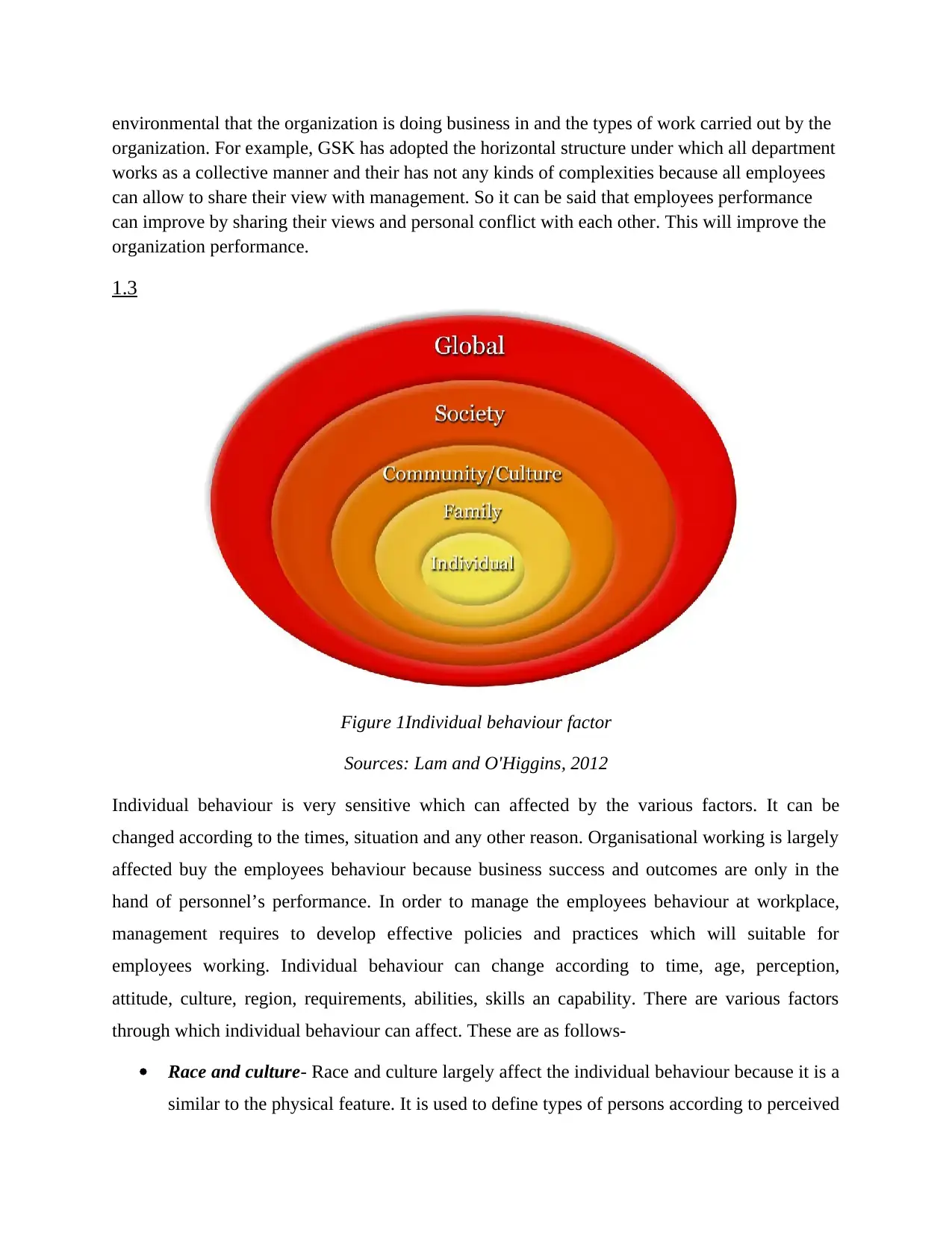
environmental that the organization is doing business in and the types of work carried out by the
organization. For example, GSK has adopted the horizontal structure under which all department
works as a collective manner and their has not any kinds of complexities because all employees
can allow to share their view with management. So it can be said that employees performance
can improve by sharing their views and personal conflict with each other. This will improve the
organization performance.
1.3
Figure 1Individual behaviour factor
Sources: Lam and O'Higgins, 2012
Individual behaviour is very sensitive which can affected by the various factors. It can be
changed according to the times, situation and any other reason. Organisational working is largely
affected buy the employees behaviour because business success and outcomes are only in the
hand of personnel’s performance. In order to manage the employees behaviour at workplace,
management requires to develop effective policies and practices which will suitable for
employees working. Individual behaviour can change according to time, age, perception,
attitude, culture, region, requirements, abilities, skills an capability. There are various factors
through which individual behaviour can affect. These are as follows-
Race and culture- Race and culture largely affect the individual behaviour because it is a
similar to the physical feature. It is used to define types of persons according to perceived
organization. For example, GSK has adopted the horizontal structure under which all department
works as a collective manner and their has not any kinds of complexities because all employees
can allow to share their view with management. So it can be said that employees performance
can improve by sharing their views and personal conflict with each other. This will improve the
organization performance.
1.3
Figure 1Individual behaviour factor
Sources: Lam and O'Higgins, 2012
Individual behaviour is very sensitive which can affected by the various factors. It can be
changed according to the times, situation and any other reason. Organisational working is largely
affected buy the employees behaviour because business success and outcomes are only in the
hand of personnel’s performance. In order to manage the employees behaviour at workplace,
management requires to develop effective policies and practices which will suitable for
employees working. Individual behaviour can change according to time, age, perception,
attitude, culture, region, requirements, abilities, skills an capability. There are various factors
through which individual behaviour can affect. These are as follows-
Race and culture- Race and culture largely affect the individual behaviour because it is a
similar to the physical feature. It is used to define types of persons according to perceived
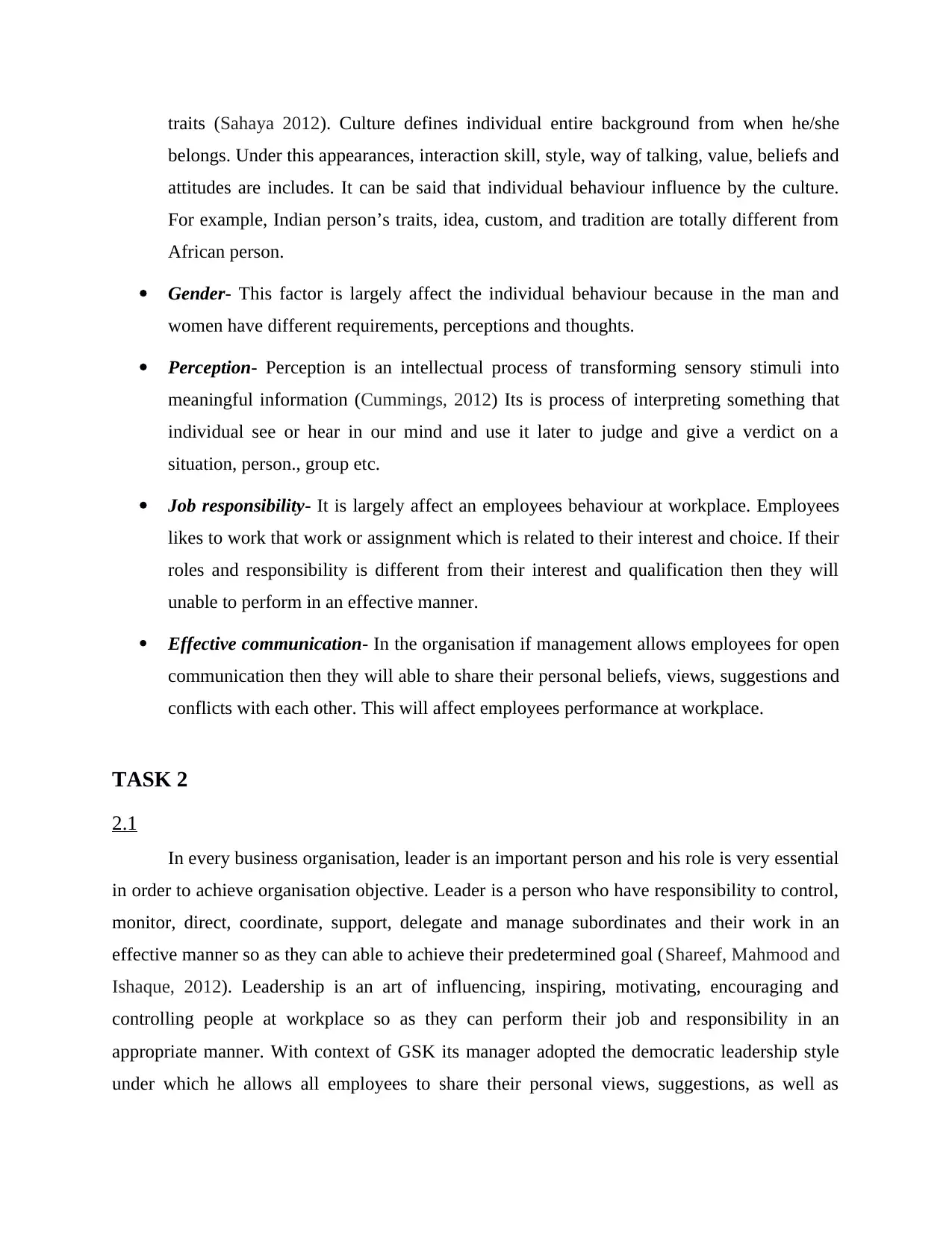
traits (Sahaya 2012). Culture defines individual entire background from when he/she
belongs. Under this appearances, interaction skill, style, way of talking, value, beliefs and
attitudes are includes. It can be said that individual behaviour influence by the culture.
For example, Indian person’s traits, idea, custom, and tradition are totally different from
African person.
Gender- This factor is largely affect the individual behaviour because in the man and
women have different requirements, perceptions and thoughts.
Perception- Perception is an intellectual process of transforming sensory stimuli into
meaningful information (Cummings, 2012) Its is process of interpreting something that
individual see or hear in our mind and use it later to judge and give a verdict on a
situation, person., group etc.
Job responsibility- It is largely affect an employees behaviour at workplace. Employees
likes to work that work or assignment which is related to their interest and choice. If their
roles and responsibility is different from their interest and qualification then they will
unable to perform in an effective manner.
Effective communication- In the organisation if management allows employees for open
communication then they will able to share their personal beliefs, views, suggestions and
conflicts with each other. This will affect employees performance at workplace.
TASK 2
2.1
In every business organisation, leader is an important person and his role is very essential
in order to achieve organisation objective. Leader is a person who have responsibility to control,
monitor, direct, coordinate, support, delegate and manage subordinates and their work in an
effective manner so as they can able to achieve their predetermined goal (Shareef, Mahmood and
Ishaque, 2012). Leadership is an art of influencing, inspiring, motivating, encouraging and
controlling people at workplace so as they can perform their job and responsibility in an
appropriate manner. With context of GSK its manager adopted the democratic leadership style
under which he allows all employees to share their personal views, suggestions, as well as
belongs. Under this appearances, interaction skill, style, way of talking, value, beliefs and
attitudes are includes. It can be said that individual behaviour influence by the culture.
For example, Indian person’s traits, idea, custom, and tradition are totally different from
African person.
Gender- This factor is largely affect the individual behaviour because in the man and
women have different requirements, perceptions and thoughts.
Perception- Perception is an intellectual process of transforming sensory stimuli into
meaningful information (Cummings, 2012) Its is process of interpreting something that
individual see or hear in our mind and use it later to judge and give a verdict on a
situation, person., group etc.
Job responsibility- It is largely affect an employees behaviour at workplace. Employees
likes to work that work or assignment which is related to their interest and choice. If their
roles and responsibility is different from their interest and qualification then they will
unable to perform in an effective manner.
Effective communication- In the organisation if management allows employees for open
communication then they will able to share their personal beliefs, views, suggestions and
conflicts with each other. This will affect employees performance at workplace.
TASK 2
2.1
In every business organisation, leader is an important person and his role is very essential
in order to achieve organisation objective. Leader is a person who have responsibility to control,
monitor, direct, coordinate, support, delegate and manage subordinates and their work in an
effective manner so as they can able to achieve their predetermined goal (Shareef, Mahmood and
Ishaque, 2012). Leadership is an art of influencing, inspiring, motivating, encouraging and
controlling people at workplace so as they can perform their job and responsibility in an
appropriate manner. With context of GSK its manager adopted the democratic leadership style
under which he allows all employees to share their personal views, suggestions, as well as
⊘ This is a preview!⊘
Do you want full access?
Subscribe today to unlock all pages.

Trusted by 1+ million students worldwide
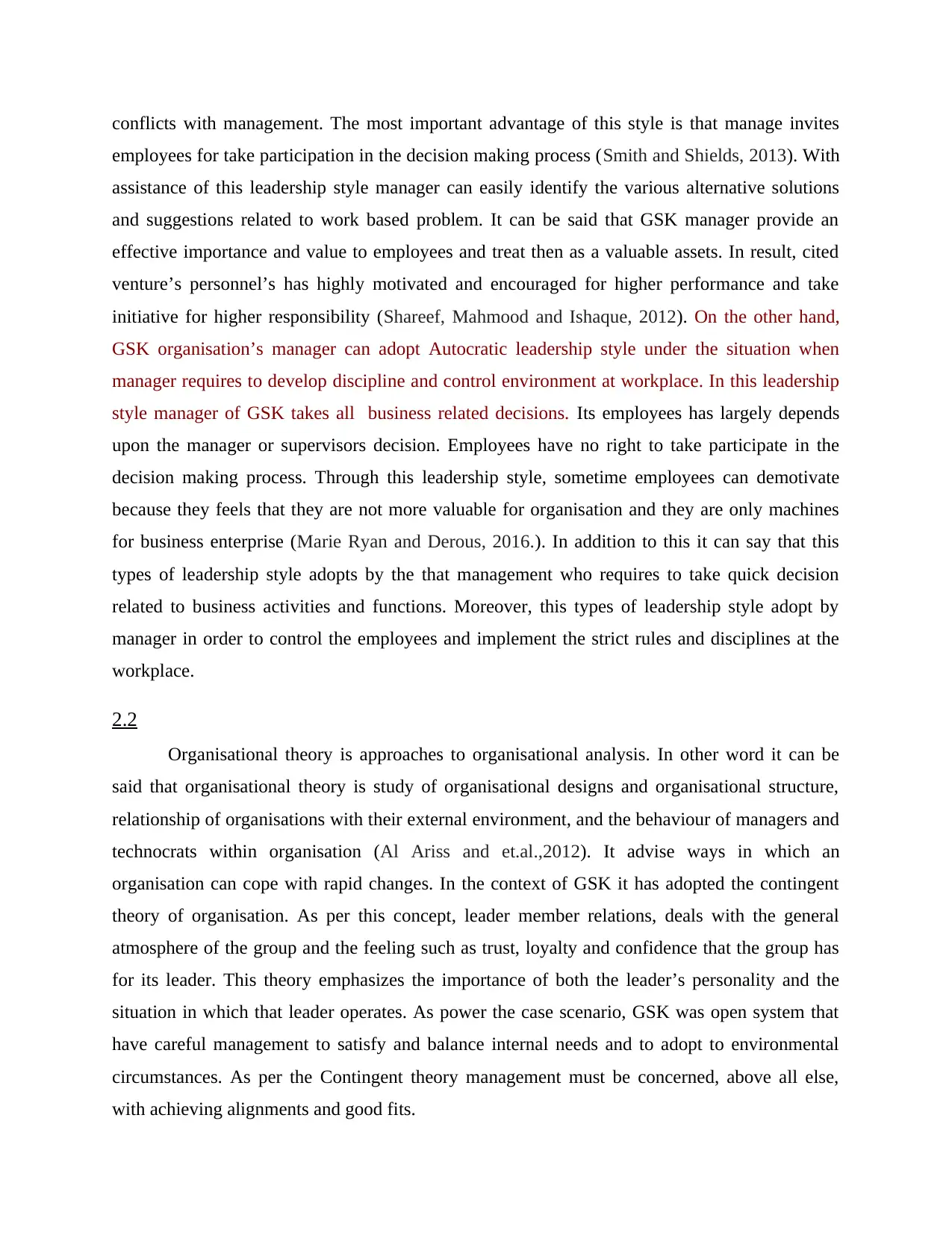
conflicts with management. The most important advantage of this style is that manage invites
employees for take participation in the decision making process (Smith and Shields, 2013). With
assistance of this leadership style manager can easily identify the various alternative solutions
and suggestions related to work based problem. It can be said that GSK manager provide an
effective importance and value to employees and treat then as a valuable assets. In result, cited
venture’s personnel’s has highly motivated and encouraged for higher performance and take
initiative for higher responsibility (Shareef, Mahmood and Ishaque, 2012). On the other hand,
GSK organisation’s manager can adopt Autocratic leadership style under the situation when
manager requires to develop discipline and control environment at workplace. In this leadership
style manager of GSK takes all business related decisions. Its employees has largely depends
upon the manager or supervisors decision. Employees have no right to take participate in the
decision making process. Through this leadership style, sometime employees can demotivate
because they feels that they are not more valuable for organisation and they are only machines
for business enterprise (Marie Ryan and Derous, 2016.). In addition to this it can say that this
types of leadership style adopts by the that management who requires to take quick decision
related to business activities and functions. Moreover, this types of leadership style adopt by
manager in order to control the employees and implement the strict rules and disciplines at the
workplace.
2.2
Organisational theory is approaches to organisational analysis. In other word it can be
said that organisational theory is study of organisational designs and organisational structure,
relationship of organisations with their external environment, and the behaviour of managers and
technocrats within organisation (Al Ariss and et.al.,2012). It advise ways in which an
organisation can cope with rapid changes. In the context of GSK it has adopted the contingent
theory of organisation. As per this concept, leader member relations, deals with the general
atmosphere of the group and the feeling such as trust, loyalty and confidence that the group has
for its leader. This theory emphasizes the importance of both the leader’s personality and the
situation in which that leader operates. As power the case scenario, GSK was open system that
have careful management to satisfy and balance internal needs and to adopt to environmental
circumstances. As per the Contingent theory management must be concerned, above all else,
with achieving alignments and good fits.
employees for take participation in the decision making process (Smith and Shields, 2013). With
assistance of this leadership style manager can easily identify the various alternative solutions
and suggestions related to work based problem. It can be said that GSK manager provide an
effective importance and value to employees and treat then as a valuable assets. In result, cited
venture’s personnel’s has highly motivated and encouraged for higher performance and take
initiative for higher responsibility (Shareef, Mahmood and Ishaque, 2012). On the other hand,
GSK organisation’s manager can adopt Autocratic leadership style under the situation when
manager requires to develop discipline and control environment at workplace. In this leadership
style manager of GSK takes all business related decisions. Its employees has largely depends
upon the manager or supervisors decision. Employees have no right to take participate in the
decision making process. Through this leadership style, sometime employees can demotivate
because they feels that they are not more valuable for organisation and they are only machines
for business enterprise (Marie Ryan and Derous, 2016.). In addition to this it can say that this
types of leadership style adopts by the that management who requires to take quick decision
related to business activities and functions. Moreover, this types of leadership style adopt by
manager in order to control the employees and implement the strict rules and disciplines at the
workplace.
2.2
Organisational theory is approaches to organisational analysis. In other word it can be
said that organisational theory is study of organisational designs and organisational structure,
relationship of organisations with their external environment, and the behaviour of managers and
technocrats within organisation (Al Ariss and et.al.,2012). It advise ways in which an
organisation can cope with rapid changes. In the context of GSK it has adopted the contingent
theory of organisation. As per this concept, leader member relations, deals with the general
atmosphere of the group and the feeling such as trust, loyalty and confidence that the group has
for its leader. This theory emphasizes the importance of both the leader’s personality and the
situation in which that leader operates. As power the case scenario, GSK was open system that
have careful management to satisfy and balance internal needs and to adopt to environmental
circumstances. As per the Contingent theory management must be concerned, above all else,
with achieving alignments and good fits.
Paraphrase This Document
Need a fresh take? Get an instant paraphrase of this document with our AI Paraphraser
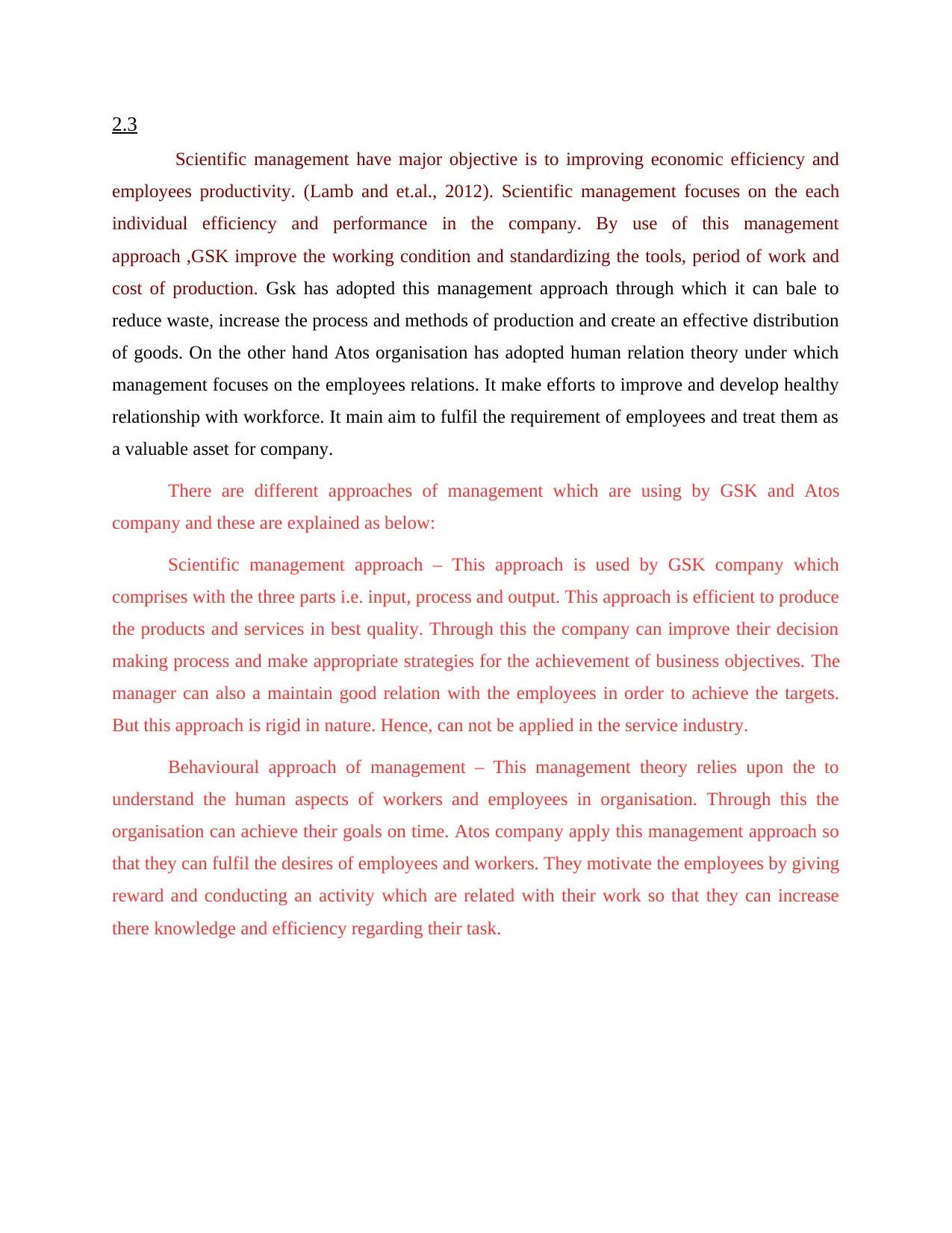
2.3
Scientific management have major objective is to improving economic efficiency and
employees productivity. (Lamb and et.al., 2012). Scientific management focuses on the each
individual efficiency and performance in the company. By use of this management
approach ,GSK improve the working condition and standardizing the tools, period of work and
cost of production. Gsk has adopted this management approach through which it can bale to
reduce waste, increase the process and methods of production and create an effective distribution
of goods. On the other hand Atos organisation has adopted human relation theory under which
management focuses on the employees relations. It make efforts to improve and develop healthy
relationship with workforce. It main aim to fulfil the requirement of employees and treat them as
a valuable asset for company.
There are different approaches of management which are using by GSK and Atos
company and these are explained as below:
Scientific management approach – This approach is used by GSK company which
comprises with the three parts i.e. input, process and output. This approach is efficient to produce
the products and services in best quality. Through this the company can improve their decision
making process and make appropriate strategies for the achievement of business objectives. The
manager can also a maintain good relation with the employees in order to achieve the targets.
But this approach is rigid in nature. Hence, can not be applied in the service industry.
Behavioural approach of management – This management theory relies upon the to
understand the human aspects of workers and employees in organisation. Through this the
organisation can achieve their goals on time. Atos company apply this management approach so
that they can fulfil the desires of employees and workers. They motivate the employees by giving
reward and conducting an activity which are related with their work so that they can increase
there knowledge and efficiency regarding their task.
Scientific management have major objective is to improving economic efficiency and
employees productivity. (Lamb and et.al., 2012). Scientific management focuses on the each
individual efficiency and performance in the company. By use of this management
approach ,GSK improve the working condition and standardizing the tools, period of work and
cost of production. Gsk has adopted this management approach through which it can bale to
reduce waste, increase the process and methods of production and create an effective distribution
of goods. On the other hand Atos organisation has adopted human relation theory under which
management focuses on the employees relations. It make efforts to improve and develop healthy
relationship with workforce. It main aim to fulfil the requirement of employees and treat them as
a valuable asset for company.
There are different approaches of management which are using by GSK and Atos
company and these are explained as below:
Scientific management approach – This approach is used by GSK company which
comprises with the three parts i.e. input, process and output. This approach is efficient to produce
the products and services in best quality. Through this the company can improve their decision
making process and make appropriate strategies for the achievement of business objectives. The
manager can also a maintain good relation with the employees in order to achieve the targets.
But this approach is rigid in nature. Hence, can not be applied in the service industry.
Behavioural approach of management – This management theory relies upon the to
understand the human aspects of workers and employees in organisation. Through this the
organisation can achieve their goals on time. Atos company apply this management approach so
that they can fulfil the desires of employees and workers. They motivate the employees by giving
reward and conducting an activity which are related with their work so that they can increase
there knowledge and efficiency regarding their task.
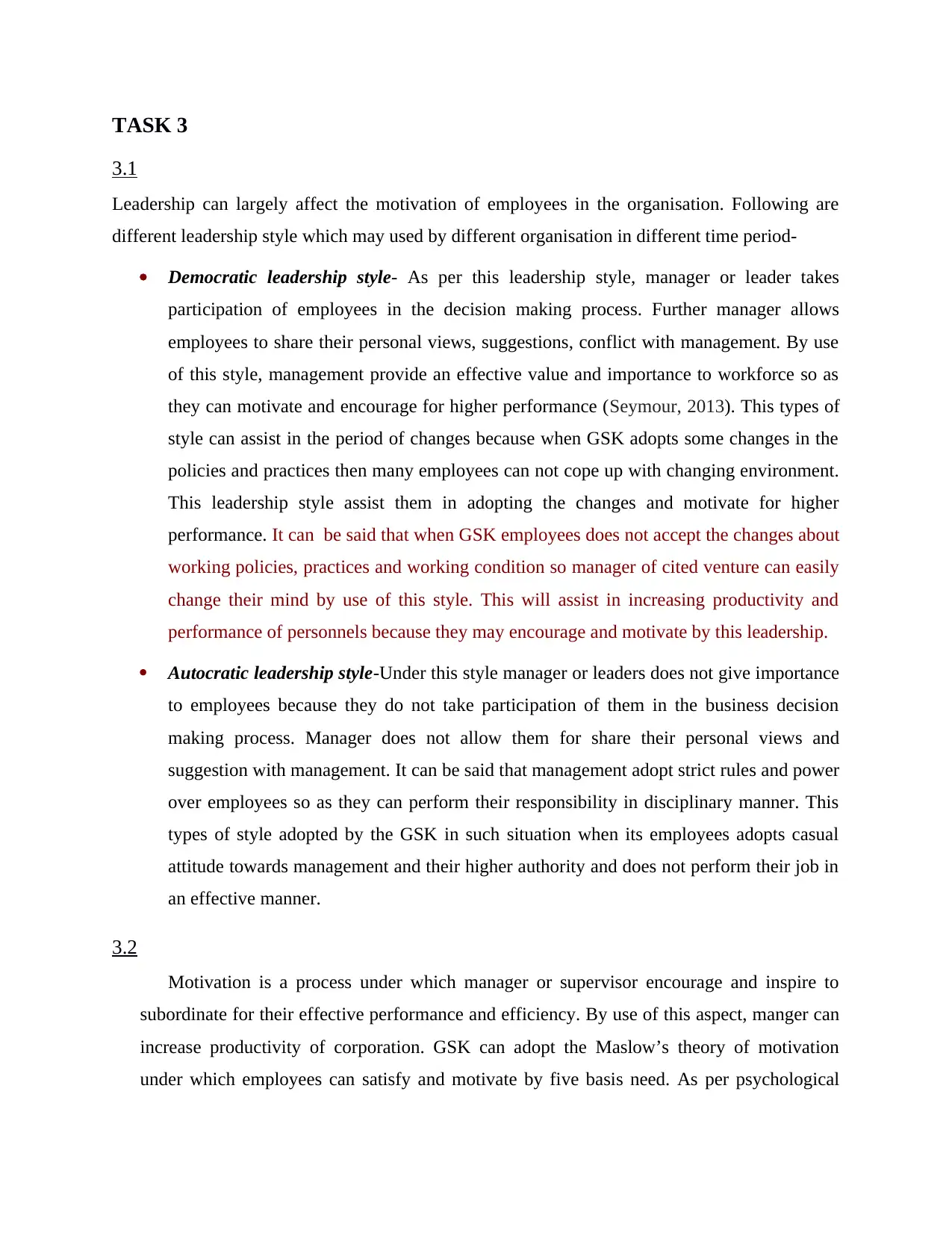
TASK 3
3.1
Leadership can largely affect the motivation of employees in the organisation. Following are
different leadership style which may used by different organisation in different time period-
Democratic leadership style- As per this leadership style, manager or leader takes
participation of employees in the decision making process. Further manager allows
employees to share their personal views, suggestions, conflict with management. By use
of this style, management provide an effective value and importance to workforce so as
they can motivate and encourage for higher performance (Seymour, 2013). This types of
style can assist in the period of changes because when GSK adopts some changes in the
policies and practices then many employees can not cope up with changing environment.
This leadership style assist them in adopting the changes and motivate for higher
performance. It can be said that when GSK employees does not accept the changes about
working policies, practices and working condition so manager of cited venture can easily
change their mind by use of this style. This will assist in increasing productivity and
performance of personnels because they may encourage and motivate by this leadership.
Autocratic leadership style-Under this style manager or leaders does not give importance
to employees because they do not take participation of them in the business decision
making process. Manager does not allow them for share their personal views and
suggestion with management. It can be said that management adopt strict rules and power
over employees so as they can perform their responsibility in disciplinary manner. This
types of style adopted by the GSK in such situation when its employees adopts casual
attitude towards management and their higher authority and does not perform their job in
an effective manner.
3.2
Motivation is a process under which manager or supervisor encourage and inspire to
subordinate for their effective performance and efficiency. By use of this aspect, manger can
increase productivity of corporation. GSK can adopt the Maslow’s theory of motivation
under which employees can satisfy and motivate by five basis need. As per psychological
3.1
Leadership can largely affect the motivation of employees in the organisation. Following are
different leadership style which may used by different organisation in different time period-
Democratic leadership style- As per this leadership style, manager or leader takes
participation of employees in the decision making process. Further manager allows
employees to share their personal views, suggestions, conflict with management. By use
of this style, management provide an effective value and importance to workforce so as
they can motivate and encourage for higher performance (Seymour, 2013). This types of
style can assist in the period of changes because when GSK adopts some changes in the
policies and practices then many employees can not cope up with changing environment.
This leadership style assist them in adopting the changes and motivate for higher
performance. It can be said that when GSK employees does not accept the changes about
working policies, practices and working condition so manager of cited venture can easily
change their mind by use of this style. This will assist in increasing productivity and
performance of personnels because they may encourage and motivate by this leadership.
Autocratic leadership style-Under this style manager or leaders does not give importance
to employees because they do not take participation of them in the business decision
making process. Manager does not allow them for share their personal views and
suggestion with management. It can be said that management adopt strict rules and power
over employees so as they can perform their responsibility in disciplinary manner. This
types of style adopted by the GSK in such situation when its employees adopts casual
attitude towards management and their higher authority and does not perform their job in
an effective manner.
3.2
Motivation is a process under which manager or supervisor encourage and inspire to
subordinate for their effective performance and efficiency. By use of this aspect, manger can
increase productivity of corporation. GSK can adopt the Maslow’s theory of motivation
under which employees can satisfy and motivate by five basis need. As per psychological
⊘ This is a preview!⊘
Do you want full access?
Subscribe today to unlock all pages.

Trusted by 1+ million students worldwide
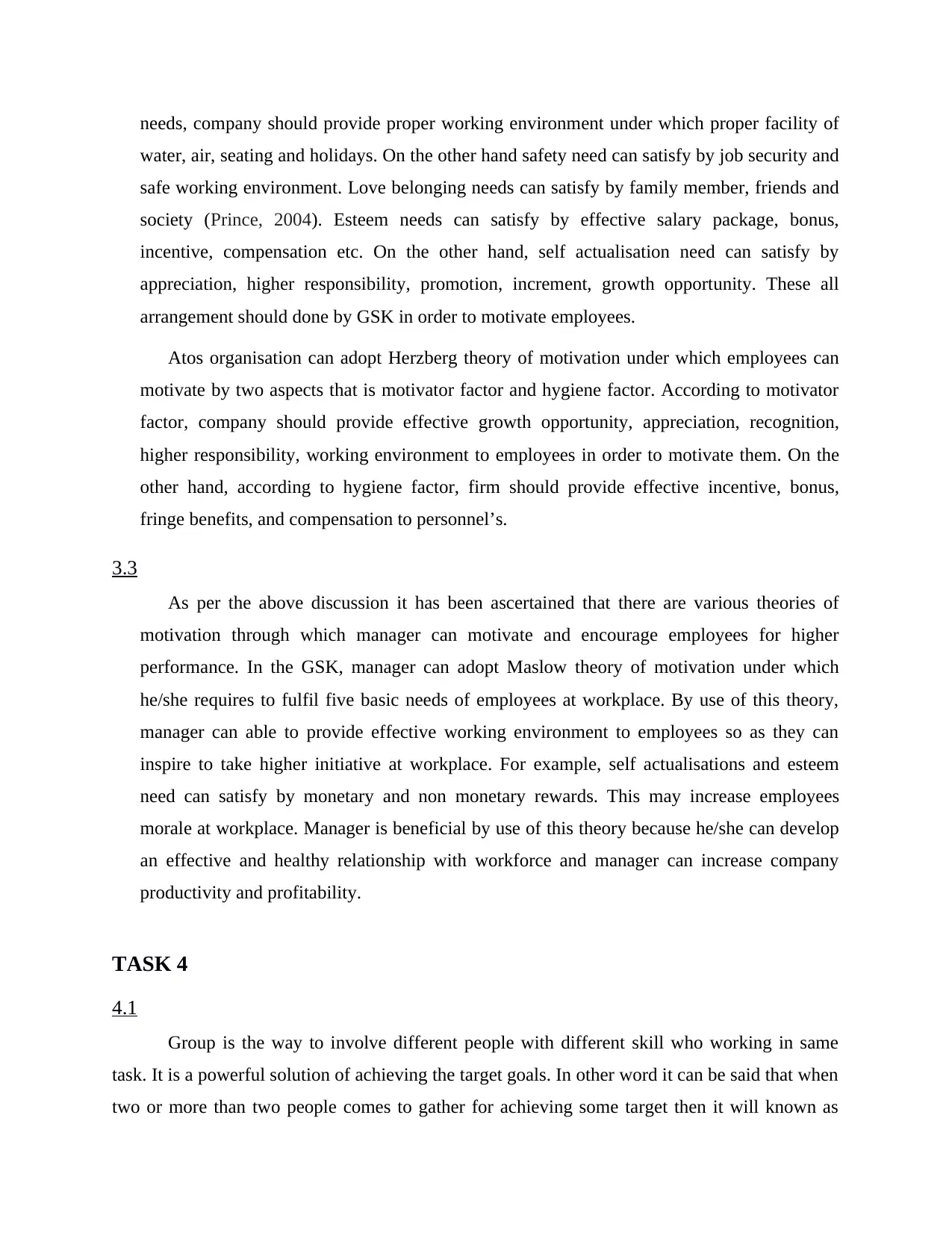
needs, company should provide proper working environment under which proper facility of
water, air, seating and holidays. On the other hand safety need can satisfy by job security and
safe working environment. Love belonging needs can satisfy by family member, friends and
society (Prince, 2004). Esteem needs can satisfy by effective salary package, bonus,
incentive, compensation etc. On the other hand, self actualisation need can satisfy by
appreciation, higher responsibility, promotion, increment, growth opportunity. These all
arrangement should done by GSK in order to motivate employees.
Atos organisation can adopt Herzberg theory of motivation under which employees can
motivate by two aspects that is motivator factor and hygiene factor. According to motivator
factor, company should provide effective growth opportunity, appreciation, recognition,
higher responsibility, working environment to employees in order to motivate them. On the
other hand, according to hygiene factor, firm should provide effective incentive, bonus,
fringe benefits, and compensation to personnel’s.
3.3
As per the above discussion it has been ascertained that there are various theories of
motivation through which manager can motivate and encourage employees for higher
performance. In the GSK, manager can adopt Maslow theory of motivation under which
he/she requires to fulfil five basic needs of employees at workplace. By use of this theory,
manager can able to provide effective working environment to employees so as they can
inspire to take higher initiative at workplace. For example, self actualisations and esteem
need can satisfy by monetary and non monetary rewards. This may increase employees
morale at workplace. Manager is beneficial by use of this theory because he/she can develop
an effective and healthy relationship with workforce and manager can increase company
productivity and profitability.
TASK 4
4.1
Group is the way to involve different people with different skill who working in same
task. It is a powerful solution of achieving the target goals. In other word it can be said that when
two or more than two people comes to gather for achieving some target then it will known as
water, air, seating and holidays. On the other hand safety need can satisfy by job security and
safe working environment. Love belonging needs can satisfy by family member, friends and
society (Prince, 2004). Esteem needs can satisfy by effective salary package, bonus,
incentive, compensation etc. On the other hand, self actualisation need can satisfy by
appreciation, higher responsibility, promotion, increment, growth opportunity. These all
arrangement should done by GSK in order to motivate employees.
Atos organisation can adopt Herzberg theory of motivation under which employees can
motivate by two aspects that is motivator factor and hygiene factor. According to motivator
factor, company should provide effective growth opportunity, appreciation, recognition,
higher responsibility, working environment to employees in order to motivate them. On the
other hand, according to hygiene factor, firm should provide effective incentive, bonus,
fringe benefits, and compensation to personnel’s.
3.3
As per the above discussion it has been ascertained that there are various theories of
motivation through which manager can motivate and encourage employees for higher
performance. In the GSK, manager can adopt Maslow theory of motivation under which
he/she requires to fulfil five basic needs of employees at workplace. By use of this theory,
manager can able to provide effective working environment to employees so as they can
inspire to take higher initiative at workplace. For example, self actualisations and esteem
need can satisfy by monetary and non monetary rewards. This may increase employees
morale at workplace. Manager is beneficial by use of this theory because he/she can develop
an effective and healthy relationship with workforce and manager can increase company
productivity and profitability.
TASK 4
4.1
Group is the way to involve different people with different skill who working in same
task. It is a powerful solution of achieving the target goals. In other word it can be said that when
two or more than two people comes to gather for achieving some target then it will known as
Paraphrase This Document
Need a fresh take? Get an instant paraphrase of this document with our AI Paraphraser
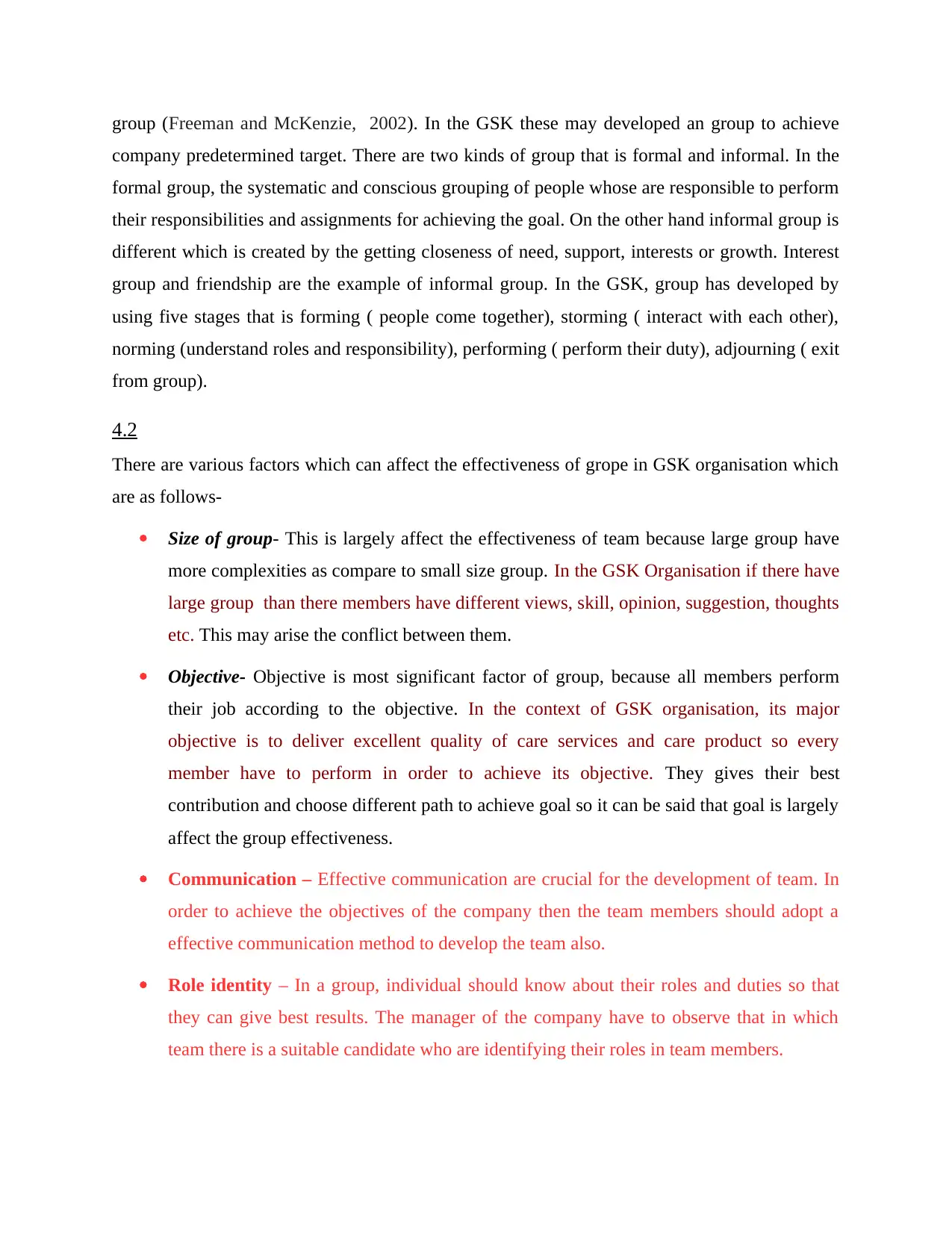
group (Freeman and McKenzie, 2002). In the GSK these may developed an group to achieve
company predetermined target. There are two kinds of group that is formal and informal. In the
formal group, the systematic and conscious grouping of people whose are responsible to perform
their responsibilities and assignments for achieving the goal. On the other hand informal group is
different which is created by the getting closeness of need, support, interests or growth. Interest
group and friendship are the example of informal group. In the GSK, group has developed by
using five stages that is forming ( people come together), storming ( interact with each other),
norming (understand roles and responsibility), performing ( perform their duty), adjourning ( exit
from group).
4.2
There are various factors which can affect the effectiveness of grope in GSK organisation which
are as follows-
Size of group- This is largely affect the effectiveness of team because large group have
more complexities as compare to small size group. In the GSK Organisation if there have
large group than there members have different views, skill, opinion, suggestion, thoughts
etc. This may arise the conflict between them.
Objective- Objective is most significant factor of group, because all members perform
their job according to the objective. In the context of GSK organisation, its major
objective is to deliver excellent quality of care services and care product so every
member have to perform in order to achieve its objective. They gives their best
contribution and choose different path to achieve goal so it can be said that goal is largely
affect the group effectiveness.
Communication – Effective communication are crucial for the development of team. In
order to achieve the objectives of the company then the team members should adopt a
effective communication method to develop the team also.
Role identity – In a group, individual should know about their roles and duties so that
they can give best results. The manager of the company have to observe that in which
team there is a suitable candidate who are identifying their roles in team members.
company predetermined target. There are two kinds of group that is formal and informal. In the
formal group, the systematic and conscious grouping of people whose are responsible to perform
their responsibilities and assignments for achieving the goal. On the other hand informal group is
different which is created by the getting closeness of need, support, interests or growth. Interest
group and friendship are the example of informal group. In the GSK, group has developed by
using five stages that is forming ( people come together), storming ( interact with each other),
norming (understand roles and responsibility), performing ( perform their duty), adjourning ( exit
from group).
4.2
There are various factors which can affect the effectiveness of grope in GSK organisation which
are as follows-
Size of group- This is largely affect the effectiveness of team because large group have
more complexities as compare to small size group. In the GSK Organisation if there have
large group than there members have different views, skill, opinion, suggestion, thoughts
etc. This may arise the conflict between them.
Objective- Objective is most significant factor of group, because all members perform
their job according to the objective. In the context of GSK organisation, its major
objective is to deliver excellent quality of care services and care product so every
member have to perform in order to achieve its objective. They gives their best
contribution and choose different path to achieve goal so it can be said that goal is largely
affect the group effectiveness.
Communication – Effective communication are crucial for the development of team. In
order to achieve the objectives of the company then the team members should adopt a
effective communication method to develop the team also.
Role identity – In a group, individual should know about their roles and duties so that
they can give best results. The manager of the company have to observe that in which
team there is a suitable candidate who are identifying their roles in team members.
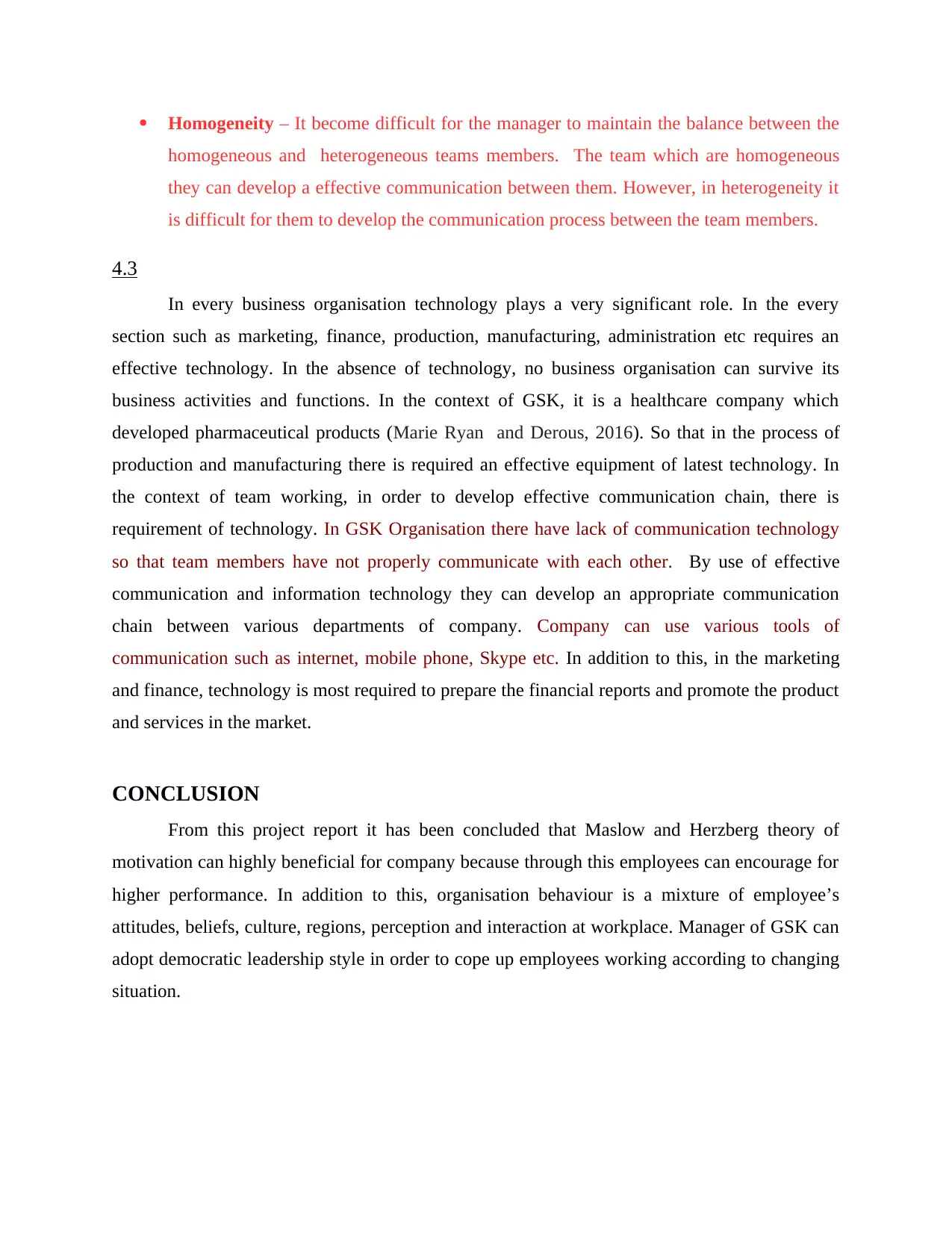
Homogeneity – It become difficult for the manager to maintain the balance between the
homogeneous and heterogeneous teams members. The team which are homogeneous
they can develop a effective communication between them. However, in heterogeneity it
is difficult for them to develop the communication process between the team members.
4.3
In every business organisation technology plays a very significant role. In the every
section such as marketing, finance, production, manufacturing, administration etc requires an
effective technology. In the absence of technology, no business organisation can survive its
business activities and functions. In the context of GSK, it is a healthcare company which
developed pharmaceutical products (Marie Ryan and Derous, 2016). So that in the process of
production and manufacturing there is required an effective equipment of latest technology. In
the context of team working, in order to develop effective communication chain, there is
requirement of technology. In GSK Organisation there have lack of communication technology
so that team members have not properly communicate with each other. By use of effective
communication and information technology they can develop an appropriate communication
chain between various departments of company. Company can use various tools of
communication such as internet, mobile phone, Skype etc. In addition to this, in the marketing
and finance, technology is most required to prepare the financial reports and promote the product
and services in the market.
CONCLUSION
From this project report it has been concluded that Maslow and Herzberg theory of
motivation can highly beneficial for company because through this employees can encourage for
higher performance. In addition to this, organisation behaviour is a mixture of employee’s
attitudes, beliefs, culture, regions, perception and interaction at workplace. Manager of GSK can
adopt democratic leadership style in order to cope up employees working according to changing
situation.
homogeneous and heterogeneous teams members. The team which are homogeneous
they can develop a effective communication between them. However, in heterogeneity it
is difficult for them to develop the communication process between the team members.
4.3
In every business organisation technology plays a very significant role. In the every
section such as marketing, finance, production, manufacturing, administration etc requires an
effective technology. In the absence of technology, no business organisation can survive its
business activities and functions. In the context of GSK, it is a healthcare company which
developed pharmaceutical products (Marie Ryan and Derous, 2016). So that in the process of
production and manufacturing there is required an effective equipment of latest technology. In
the context of team working, in order to develop effective communication chain, there is
requirement of technology. In GSK Organisation there have lack of communication technology
so that team members have not properly communicate with each other. By use of effective
communication and information technology they can develop an appropriate communication
chain between various departments of company. Company can use various tools of
communication such as internet, mobile phone, Skype etc. In addition to this, in the marketing
and finance, technology is most required to prepare the financial reports and promote the product
and services in the market.
CONCLUSION
From this project report it has been concluded that Maslow and Herzberg theory of
motivation can highly beneficial for company because through this employees can encourage for
higher performance. In addition to this, organisation behaviour is a mixture of employee’s
attitudes, beliefs, culture, regions, perception and interaction at workplace. Manager of GSK can
adopt democratic leadership style in order to cope up employees working according to changing
situation.
⊘ This is a preview!⊘
Do you want full access?
Subscribe today to unlock all pages.

Trusted by 1+ million students worldwide
1 out of 15
Related Documents
Your All-in-One AI-Powered Toolkit for Academic Success.
+13062052269
info@desklib.com
Available 24*7 on WhatsApp / Email
![[object Object]](/_next/static/media/star-bottom.7253800d.svg)
Unlock your academic potential
Copyright © 2020–2025 A2Z Services. All Rights Reserved. Developed and managed by ZUCOL.





